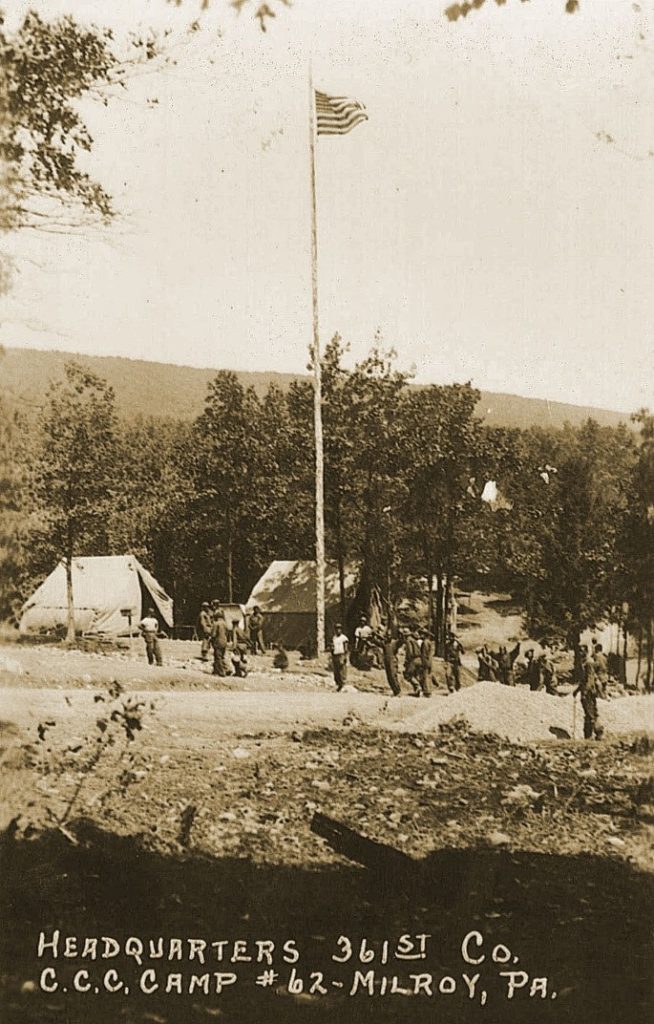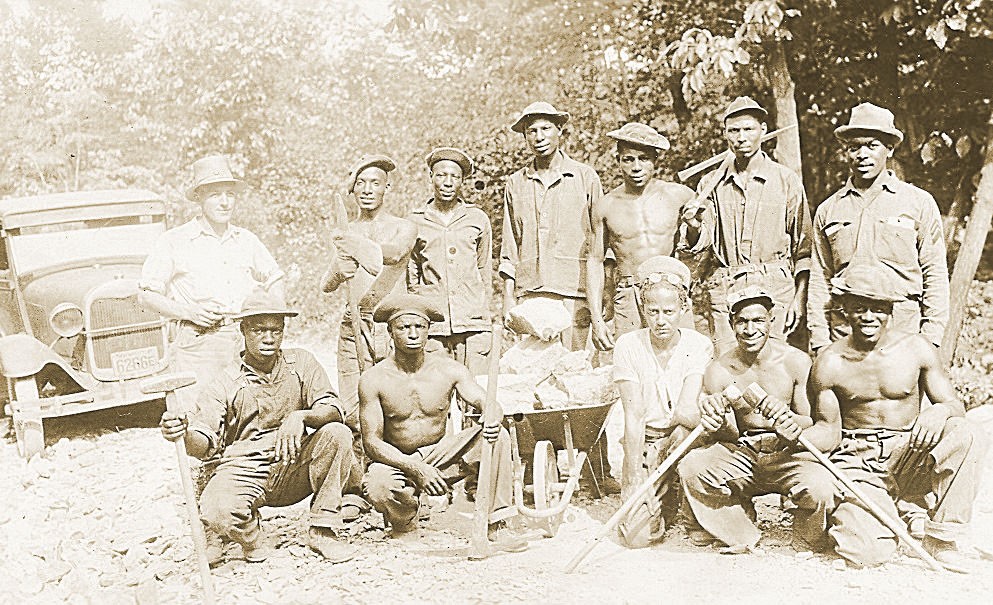Like sports, the various musical and entertainment groups that were organized at Camp S-62 helped to develop a strong social connection between the men of Company 361-C and the surrounding community. It is also evident through the weekly newspaper reports that these groups constituted a major part of the social life within Company 361-C.[1]

Pictured above is the parade grounds at Camp S-62 shortly after the camp was established in the summer of 1933. (Courtesy of the Pennsylvania CCC Online Archive)
Perhaps one of the more famous groups to emerge from the camp was the Penn Roosevelt Quintet.[2] Formed shortly after the camp was established, the group performed for different social and religious events throughout the region. Some of the frequent gatherings in which the group performed at were singing tournaments, church programs, political events, and even for prisoners at the State Penitentiary in Bellefonte.[3] One singing tournament that the quintet performed at was held at an A.M.E. Church in Mt. Union. Here the men took home first “prize” valued at $10 while second “prize” was won by another African American group from nearby Camp S-56 (East Licking Creek).[4] The quintet became so favorable among the local communities that “invitations for their services” came “almost daily.”[5] However, the neighboring people were not the only ones to hear the singing talents of the Penn Roosevelt Quintet. The renowned group also received fifteen minutes of airtime on Harrisburg’s WHP radio station between early 1934 and late 1935.[6] Moreover, they were also heard on Williamsport’s WRAK radio station. This opportunity was made possible by the efforts of the camp’s commander, Captain Arthur T. Eaker and his wife when the group was invited to their home in Muncy, Pennsylvania. While there, the group performed at the Muncy Hotel and the Methodist Church in the town.[7] Their musical performances were composed of popular contemporary pieces in addition to “negro spirituals,” in which they specialized.[8] Some of the documented members of the group are as follows:
Penn-Roosevelt Quintet Members (April 1934)[9]
- 2nd Tenor and Manager Claude T. Bailey
- 1st Tenor John S. Reid
- 2nd Tenor Herman Laws
- Baritone William H. Bryant
- Bass Loomis Edwards
Along with the Penn Roosevelt Quintet, the camp was host to a number of other singing groups. One of the early groups that formed around the same time as the quintet were the “Bon-Bons”. This group was equally successful, often performing in conjunction with the quintet. One joint performance that was mentioned included an annual ball for R.O.T.C. officers at the Pennsylvania State College, now Penn State University, in which the men provide the evening entertainment.[10] The “Bon-Bons” likewise aired on Harrisburg’s WHP radio station.[11] However, despite their success, the “lauded entertainers” of the “Bon-Bons” left camp for home in late March 1934.[12] Another group was the “Six Careless Chords” which likely formed in late 1934. This group consisted of both instrumental and vocal music and similarly saw airtime on the WHP radio station.[13] At the time of the company’s transfer in the fall of 1935 to Camp S-69 in Beaver Springs, the “Six Careless Chords” and the Penn Roosevelt Quintet were the two active musical groups at S-62. Members of this group from March 1935 are as follows:
“Six Careless Chords” Members (March 1935)[14]
- Managed by Norman Handy
- 1st tenor Donald Gaskin
- 2nd tenor Richard Henry
- Baritone Daniel Wilson
- Baritone Fred Hollingsworth
- 1st bass Rupert Burns
- 2nd bass Joseph Bryant
It seems appropriate here to also include the “Hi-Celebrity Club” within this survey of musical groups at Camp S-62. Regrettably, there was not much information that was documented about this particular group in the early days of the camp. As of November 1933, the seventeen member group was described as being at the “top of the pile” after originating as the “laughing stock of the camp.”[15] While mention of the group is limited, their involvement in a three day conclave, held in Coatesville over the men’s Christmas break in 1933, did not go unnoticed by the newspaper. During this conclave, the group performed at company member “Midget” Smith’s residence.[16] With the limited perspective that is given, it is most reasonable to assume that the “Hi-Celebrity Club” was one of many musical groups at Camp S-62.
In addition to singing, the men of Company 361-C also formed entertainment groups. One that was briefly mentioned was an unnamed minstrel group that appeared to be active in late 1933. This group appeared to be quite popular among the local community as they held their second performance in Lewistown in front of a “packed house.”[17] While this demonstrates the group’s prominence within the local community, it can also reveal the popularity of racialized entertainment of the 1930s. At this particular performance, George Harris, “the ‘Bing Crosby’ of the cast, pleased the crowd with [songs like] ‘Don’t Blame Me’, ‘Lazy Bones’, and ‘Under A Blanket of Blue’.”[18] Unfortunately, not much information regarding this group was further documented in the weekly newspapers having no reference to the group being made after February 1934. The men also formed the Penn Roosevelt Dramatic Club in the spring of 1935, under the direction of Educational Advisor Clarence Grinnell. This club often performed at the Bethel A.M.E. church in Lewistown and the A.M.E. church in Mt. Union. At such presentations, the group’s rendition of “The Seventh Doctor” proved to be very favorable among the audience.[19]

Pictured above is the road crew made up of men from Company 361-C. Foreman Walter Kauffman is standing on the left in the back row. (Courtesy of the Pennsylvania CCC Online Archive)
Yet again, the men of Company 361-C demonstrated their exceptional talents through entertainment and musical performances. These groups gained recognition from both the local community and the central Pennsylvania region as a whole. They undoubtedly helped to further strengthen the relationship between Camp S-62 and the local community at a time when white communities opposed the establishment of African American camps near them.[20] Within the camp itself, these groups helped to further cultivate a rich social life among the men. One of the remaining features of camp life for Company 361-C was the educational opportunities that were available to them. This will be the topic of discussion in the final upcoming blog post.
This article is one in a series issued throughout February in honor of African American History Month written by Jacob Hockenberry based off information compiled through a summer research opportunity. Jacob is a senior at Shippensburg University where he is studying history, political science, and geographic information systems (GIS). He intends on furthering his education by pursuing a master’s degree in historic preservation.
To receive notifications about upcoming blog posts, updates on Pennsylvania’s state parks and forests, and events and happenings with PPFF Friends Chapters around the state, sign up to receive our weekly Take Five e-blast.
Resources:
[1] There were several other small singing groups that the men formed at camp S-62, however, there was insufficient information reported about these groups.
[2] Mention of a “Stone Creek Quintet” made in later newspaper reports is believed to be referring to the Penn Roosevelt Quintet.
[3] “Milroy Camp,” Philadelphia Tribune, February 1, 1934; “Spike” Spady, “Camp Milroy,” Philadelphia Tribune, February 22, 1934; William H. Bryant, “Camp Milroy,” Philadelphia Tribune, May 24, 1934; William H. Bryant, “Milroy, Pa.,” Philadelphia Tribune, June 28, 1934.
[4] “Camp Milroy,” Philadelphia Tribune, April 19, 1934.
[5] “Milroy Camp,” Philadelphia Tribune, February 1, 1934.
[6] “Milroy Camp,” Philadelphia Tribune, February 1, 1934; Cheyney H. Thomas, “Camp Milroy,” Philadelphia Tribune, March 1, 1934; “Camp Milroy,” Philadelphia Tribune, April 19, 1934.
[7] William H. Bryant, “Camp Milroy,” Philadelphia Tribune, April 26, 1934.
[8] “Milroy Camp Boxing Bouts Reach Finals,” Philadelphia Tribune, November 30, 1933; “Camp Milroy,” Philadelphia Tribune, April 19, 1934; Bud ‘N Yub, “C.C.Camp, Milroy, Pa.,” Philadelphia Tribune, September 26, 1935.
[9] “Camp Milroy,” Philadelphia Tribune, April 19, 1934.
[10] “Milroy Camp,” Philadelphia Tribune, February 1, 1934.
[11] “Spike” Spady, “Camp Milroy,” Philadelphia Tribune, February 22, 1934; Cheyney H. Thomas, “Camp Milroy,” Philadelphia Tribune, March 1, 1934.
[12] Cheyney H. Thomas, “Camp Milroy,” Philadelphia Tribune, March 22, 1934.
[13] Bud ‘N Yub, “Camp S-62, Pa., Milroy,” Philadelphia Tribune, October 18, 1934; Bud ‘N Yub, “C.C. Camp, Milroy, Pa.,” Philadelphia Tribune, October 10, 1935.
[14] Bub N’ Yub, 361st Co. C.C.C. Milroy, Pa.,” Philadelphia Tribune, March 28, 1935.
[15] “Milroy Camp Boys Witness Boxing Bouts,” Philadelphia Tribune, November 2, 1933.
[16] Arthur O. Spady, “Basketball Attraction At Milroy Camp,” Philadelphia Tribune, December 21, 1933; “Milroy Camp,” Philadelphia Tribune, January 25, 1934.
[17] “Milroy Camp Boxing Bouts Reach Finals,” Philadelphia Tribune, November 30, 1933.
[18] Ibid.
[19] Bud ‘N Yub, “Penn-Roosevelt Milroy, Penna.,” Philadelphia Tribune, May 16, 1935; Bud N’ Yub, “Penn-Roosevelt,” Philadelphia Tribune, July 25, 1935.
[20] John A. Salmond, “The Civilian Conservation Corps and the Negro,” Journal of American History 52, no.1 (June 1965): 80; Kenneth E. Hendrickson Jr., “The Civilian Conservation Corps in Pennsylvania: A Case Study of a New Deal Relief Agency in Operation,” Pennsylvania Magazine of History and Biography 100, no. 1 (January 1976): 84.




